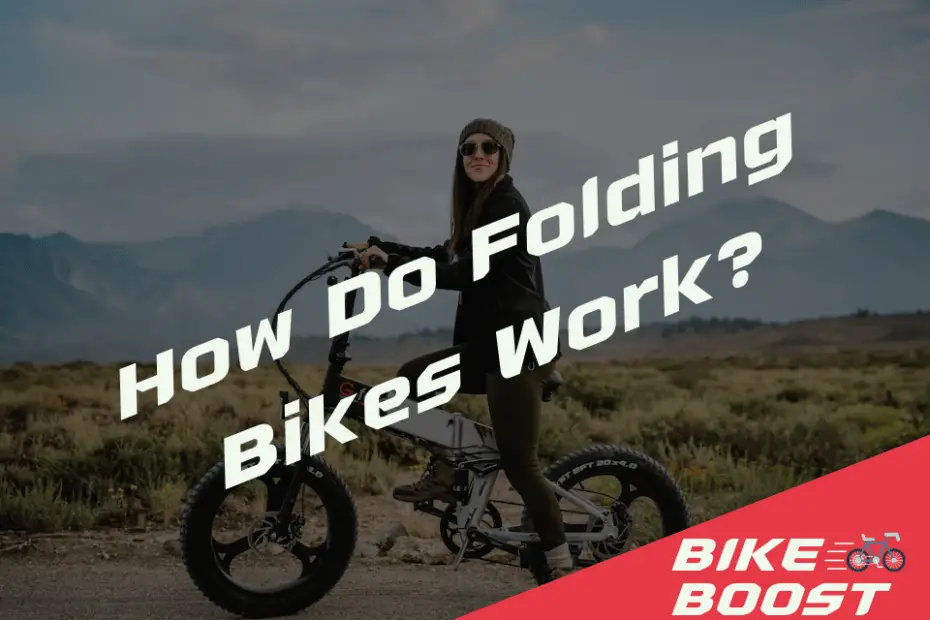Have you ever wondered how folding bikes work? These ingenious compact bicycles have been gaining popularity in recent years due to their versatility and convenience. Whether you’re a city commuter, an adventurer, or simply someone who appreciates smart design, folding bikes offer a unique solution to your transportation needs. In this article, we will delve into the world of folding bikes, exploring their components, folding mechanisms, designs, and the benefits they provide. So let’s unfold the secrets and discover how these remarkable bicycles work.
What are Folding Bikes?
Folding bikes, also known as foldable bicycles, are specially designed bicycles that offer the convenience of compactness. Unlike traditional bicycles, folding bikes feature mechanisms that allow them to be easily folded and unfolded, making them highly portable and suitable for various situations. Whether you’re commuting to work, traveling on public transportation, or exploring new places, folding bikes provide a practical and efficient means of transportation.
Components of Folding Bikes
To understand how folding bikes work, it’s essential to familiarize ourselves with their key components:
- Frame: The frame of a folding bike is typically made from lightweight materials such as aluminum or carbon fiber. These materials ensure durability while keeping the overall weight of the bike low.
- Wheels: Folding bikes often feature smaller wheels compared to traditional bicycles. These wheels strike a balance between stability and compactness, making them ideal for navigating urban environments.
- Gears and Drivetrain: Folding bikes come equipped with a range of gears, allowing riders to adapt to different terrains and inclines. The drivetrain consists of components such as the chain, derailleur, and crankset, enabling efficient power transfer.
- Brakes: Folding bikes utilize various brake systems, including rim brakes, disc brakes, or a combination of both. These braking mechanisms ensure reliable stopping power and safety.
- Handlebars and Stem: The handlebars on folding bikes can be adjustable, allowing riders to find a comfortable riding position. The stem, which connects the handlebars to the frame, may also feature a quick-release mechanism for easy folding.
Folding Mechanisms
The magic of folding bikes lies in their folding mechanisms. Different folding bike models employ various folding techniques, each with its unique advantages. Let’s explore some popular folding mechanisms:
- Mid-fold or Triangle Hinge: This folding mechanism allows the bike to fold in half, with the rear wheel swinging under the main frame. It often features a hinge in the middle of the frame, creating a compact and easily maneuverable package.
- Vertical Fold or Breakaway Hinge: In this folding mechanism, the bike’s frame separates into two halves, vertically folding the bike. This design is particularly useful when storage space is limited, as it creates a narrow and upright package.
- Magnet or Clamp Mechanisms: Some folding bikes incorporate magnet or clamp mechanisms to secure the folded bike in place. These additional features provide stability during transportation and prevent accidental unfolding.
- Telescopic or Folding Seatpost: The seatpost of a folding bike may also have a telescopic or folding design, allowing riders to adjust the seat height and fold it down for compactness.
Folding Bike Designs
Folding bikes come in various designs, each catering to different needs and preferences. Let’s explore a few popular designs:
- Brompton: The Brompton design is known for its compactness and user-friendly folding mechanism. These bikes fold into a small package, making them easy to carry and store, even in tight spaces.
- Tern: Tern folding bikes are renowned for their sturdy frames and smooth folding mechanisms. They often feature larger wheels, providing a more comfortable ride while maintaining foldability.
- Dahon: Dahon folding bikes offer a wide range of models suitable for different riding styles and terrains. They are known for their durability and versatility, making them popular among commuting and touring cyclists.
Benefits of Folding Bikes
Folding bikes offer a multitude of benefits that make them an attractive option for many riders:
- Portability: The ability to fold and carry a bike easily is perhaps the most significant advantage of folding bikes. They can be conveniently transported on public transportation, stored in compact spaces, or even taken on trips.
- Commuting: Folding bikes are excellent for urban commuting, allowing riders to navigate traffic, park effortlessly, and seamlessly transition between cycling and other modes of transport.
- Multimodal Transport: Folding bikes complement public transportation, enabling riders to combine cycling with trains, buses, or other means of transit. This flexibility makes daily commuting and travel more convenient and efficient.
- Fitness and Recreation: Folding bikes are not limited to commuting; they can also be used for leisurely rides and recreational activities. Whether it’s exploring new bike paths or embarking on weekend adventures, folding bikes provide a versatile means of enjoying the outdoors.
- Eco-Friendly: By choosing a folding bike as your mode of transportation, you contribute to reducing carbon emissions and promoting a greener environment. Folding bikes are an eco-friendly alternative to traditional vehicles.
Choosing the Right Folding Bike
When selecting a folding bike, consider the following factors:
- Intended Use: Determine whether you’ll primarily use the bike for commuting, leisure rides, or a combination of both.
- Foldability and Portability: Assess the folding mechanism and size of the folded bike to ensure it meets your storage and transportation needs.
- Frame Material: Consider the durability and weight of the frame material. Aluminum frames are lightweight, while carbon fiber frames offer a balance of strength and weight.
- Wheel Size: Determine the wheel size based on your riding preferences. Smaller wheels offer increased maneuverability, while larger wheels provide a smoother ride.
- Gears and Accessories: Choose a folding bike with gears suitable for your riding environment. Additionally, consider accessories such as fenders, racks, and lights for added convenience and safety.
Maintenance Tips
To keep your folding bike in optimal condition, follow these maintenance tips:
- Regular Cleaning: Clean your folding bike after rides, removing dirt and debris from the frame, gears, and brakes. Use a soft brush and a mild cleaning solution to prevent damage.
- Lubrication: Apply lubricant to the chain, derailleurs, and other moving parts regularly to ensure smooth operation. Wipe off any excess lubricant to prevent attracting dirt.
- Tire Maintenance: Check tire pressure regularly and inflate them to the recommended level. Inspect the tires for signs of wear and replace them if necessary.
- Folding Mechanism Inspection: Periodically inspect the folding mechanism for any signs of wear or misalignment. Lubricate the folding joints if needed and ensure all bolts are tightened properly.
- Storage: Store your folding bike in a dry place to prevent rust and corrosion. If the bike is folded for an extended period, unfold and ride it occasionally to maintain the folding mechanisms’ functionality.
How Do Folding Bikes Work?
Now, let’s dive into how folding bikes work. The folding process typically involves the following steps:
- Release Mechanisms: Identify the release mechanisms specific to your folding bike model. These may include quick-release levers, latches, or buttons located at various points on the bike.
- Foldable Components: Fold or disassemble the components as instructed by the manufacturer. This may involve folding the frame, folding the handlebars, or releasing the seatpost.
- Secure and Lock: Once the bike is folded, secure any latches, magnets, or clamps to keep the bike in its folded position. Ensure everything is locked securely before moving or carrying the bike.
When unfolding the bike, follow the reverse process, releasing any locks, unfolding components, and ensuring everything is securely locked in the riding position. Always refer to the manufacturer’s instructions for your specific folding bike model.
Conclusion
Folding bikes provide a convenient, compact, and efficient solution to modern transportation needs. Their folding mechanisms, diverse designs, and portability make them a practical choice for urban commuting, recreational rides, and adventure seekers. By understanding how folding bikes work and considering the various factors involved in choosing one, you can find the perfect folding bike that suits your lifestyle. Embrace the freedom and flexibility of folding bikes, and let these remarkable machines revolutionize the way you move.
Folding Bike FAQs
Are folding bikes as durable as regular bikes?
Yes, folding bikes can be just as durable as regular bikes, as they are built with quality materials and components. It’s important to choose a reputable brand and ensure proper maintenance for longevity.
Can I adjust the seat height on a folding bike?
Most folding bikes allow seat height adjustments to accommodate different riders. Check the seatpost design and adjustability options of your specific folding bike model.
How long does it take to fold and unfold a folding bike?
The time required to fold and unfold a folding bike varies depending on the specific model and your familiarity with the process. With practice, it can be done in a matter of minutes.
Can I take a folding bike on public transportation?
Yes, folding bikes are often allowed on public transportation, including buses, trains, and ferries. However, regulations may vary, so it’s advisable to check with the specific transportation service beforehand.
Are folding bikes suitable for long-distance rides?
Folding bikes can be suitable for long-distance rides, especially if they are equipped with comfortable features and a sturdy frame. Consider your comfort requirements and choose a model accordingly.
Andy is an avid cyclist who enjoys nothing more than a ride out in the hills. Competing in track, road, time trial and mountain bike events in the past, he prefers slower rides out with his family these days.

